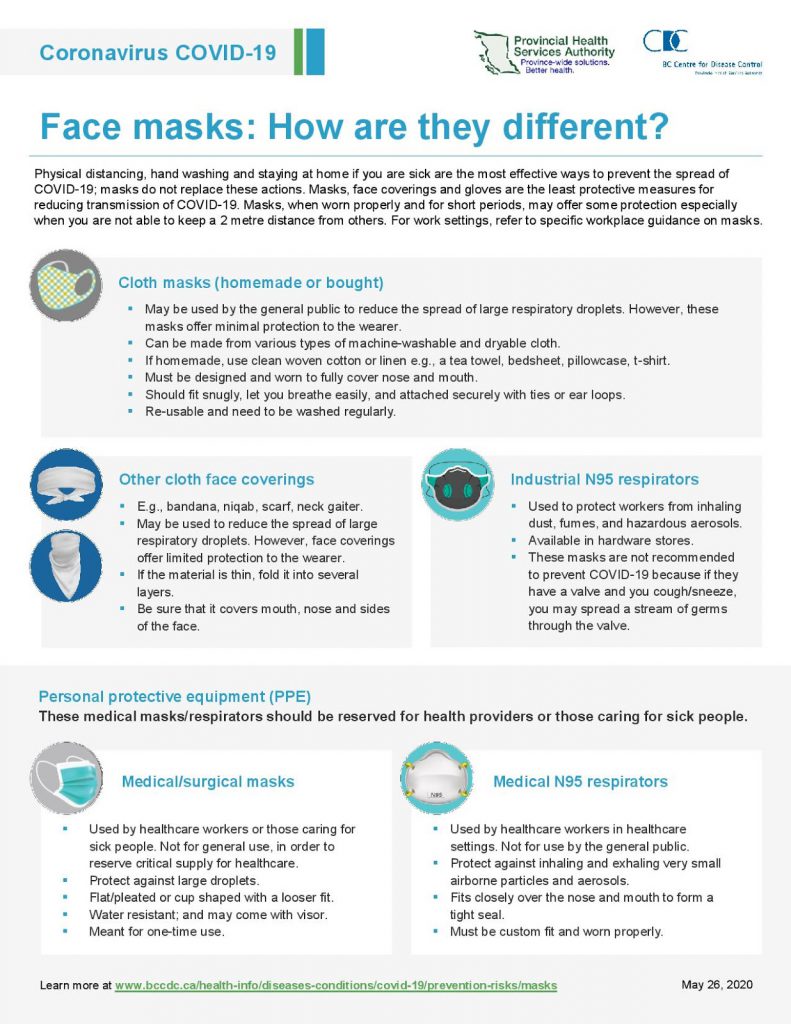Wearing Masks and How They Help
Wearing a mask is recommended in public indoor settings for people 12+ years old who are not fully vaccinated. Even if you’re fully vaccinated, you may choose to wear a mask, and that’s okay! Do what feels comfortable for you and respect other people’s choices to wear or not wear a mask as well.
Masks play a role in preventing the spread of COVID-19 by acting as a barrier to help stop the spread of droplets from a person’s mouth and nose when doing things like talking, laughing, coughing and sneezing. Masks can help protect others, especially caregivers and people that have COVID-19.
Wearing a mask should be used with frequent hand washing and physical distancing. Using only a mask is not enough to prevent the spread of COVID-19.
Wear a mask per the provincial guidelines
Wearing a mask is recommended in public indoor settings for people 12+ years old who are not fully vaccinated. Public indoor settings includes spaces like transit, movie theatres and shopping centres.
Remember, even a great mask will have minimal effect if it is not used together with other preventive measures, such as frequent hand washing and physical distancing.
Wear a mask if you are sick
COVID-19 is spread through infected droplets from a sick person’s mouth or nose. Wearing a mask if you have COVID-19 or even symptoms of COVID-19 (and have not been tested) helps protect people around you from the droplets that carry the virus. However, wearing a mask while sick does not replace the need to stay home.
It may be tricky to physically distance yourself from others at home. If you are sick, a mask can help prevent the spread of germs within the household.
Wear a mask if you are caring for someone with COVID-19
It is recommended to wear a medical/surgical mask if you are caring for a person with symptoms of COVID-19, especially if you will be in direct contact with a sick person’s droplets, saliva or body fluid.
If you do not have a medical/surgical mask, the person who is sick should wear a non-medical masks or face coverings (e.g. homemade cloth masks, dust mask, bandanas) as long as it does not make it more difficult to breathe. This will reduce the spread of droplets containing the virus to others in the home. These non-medical masks may also be worn by any household member providing care to the person who is sick.
For more information see the guide for household members of those with COVID-19.
Types of masks
Homemade masks should have at least three layers to make sure that droplets don’t pass through the fabric. An example of a mask with three layers could include:
-
- an inner layer that is in contact with the person’s face, be made of absorbent material (e.g. cotton or cotton blend)
- a middle layer of non-absorbent or absorbent material (polyester or cotton)
Even with three layers, the most important thing is that your mask fits well. A properly fitted mask sits closely over the mouth, nose, cheeks and chin of the person wearing it. The mask will be less effective if the shape or the material has gaps in it because it will allow droplets to pass through.
Wearing masks properly:
https://www.youtube.com/watch?v=gvLA–hGU70&feature=emb_logo
Things to Note while Wearing a mask:
- Touch the mask as little as possible while wearing it. It is important to make sure the mask can be held in place comfortably with ties or ear loops to reduce the need to adjust the mask. If it is not comfortable, you won’t want to wear it consistently.
- Don’t share. Masks should only be used by one person.
Storage, cleaning and disposing of masks
Medical/surgical masks should not be cleaned and reused because putting them in the washing machine may damage the protective layers and make them less effective. All masks should be changed if they are wet or dirty; try not to wear a a wet mask for an extended period of time.
To dispose of masks after use:
- Wash your hands with soap and water before taking off your mask.
- Dispose of the used mask in a waste basket lined with a plastic bag.
- After taking off your mask, wash your hands again with soap and water before touching your face or doing anything else.
Homemade or cloth masks should be cleaned and changed often:
- To clean a homemade cloth mask, wash it using the directions on the original material (for example, if the mask was made from t-shirt material, follow the washing instructions on the t-shirt tag). In general, warmer water is better if you don’t know the type of material. Dry the mask completely (in the dryer using a warm/hot setting if possible).
- Store the face covering in a paper bag, envelope, or something that does not retain moisture if you will be wearing it again.
- Do not shake dirty masks to minimize spreading germs and particles through the air. If dirty cloth masks have been in contact with someone who is sick they can still be washed with other people’s laundry.
Note: Any damage, fabric break down, or change in fit will reduce the already limited protection of cloth masks.
For the most up to date information and recommendations for wearing masks, see BCCDC’s information on Masks.
Find out more about Foundry.
